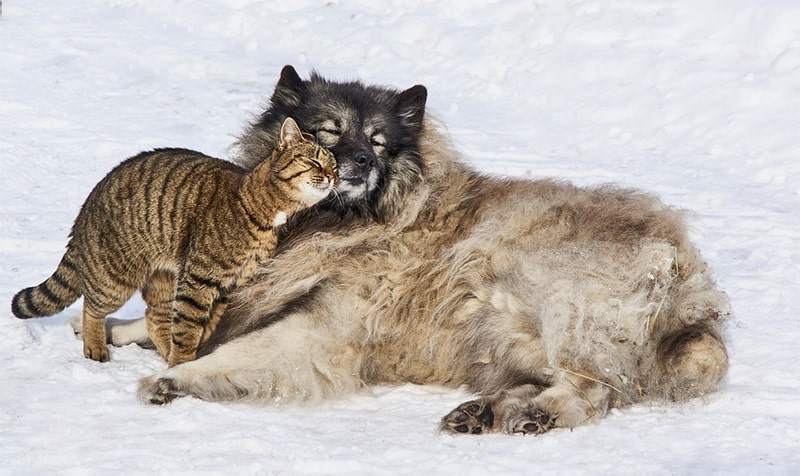Do Cats Have the Same Emotions as Dogs?
There is a great divide in the world’s population. A divide which no amount of education, debate, or interaction seems able to mend: dog people vs. cat people. Only 11% of people consider themselves “cat people”, which means we at Cats Are On Top are definitely in the minority.
The preference for dogs over cats is generally based on the idea that cats are less loving and friendly than dogs. Whilst some breeds are friendlier than others, cats are perceived to be hostile, spiteful and unemotional- traits that in a human would make us run a mile. Dogs, on the other hand, are supposedly enthusiastic, boisterous and loving pets. Most of these statements are based on casual conversations and experiences with our own pets, but most of us probably have not spent the time really researching the question.
On the surface, it seems as though cats and dogs have totally different emotions. But is that the case, or do they express their emotions in different ways? Do cats or dogs even have emotions? How would we even know?
Well, a good place to start answering this question is asking the owners. Researchers at Kyoto University did just that; they asked cat and dog owners to describe certain behaviors they observed in their pets. The owners were asked to rate whether they thought their pet shows basic emotions, such as sadness, happiness, fear or anger. They were then asked whether they believed their pet could exhibit more complex emotions, such as sympathy, compassion, jealousy or pity.
When it came to basic emotions, cat and dog owners believed almost equally that they observed theses basic emotions in their pets and there was barely any difference between the two species. The only small difference was that more dog owners believed their pets were capable of showing sadness.
The differences began to really show when owners were asked about the higher, more complex social emotions. Overall, dog owners felt that their pets were more likely to exhibit signs of these more complex emotions than cat owners. Most interestingly, more dog owners believed that their pets were able to show compassion, pity and sympathy- the three emotions associated with empathy.
If a dog is able to empathize, they are able to recognize and respond to another person’s feelings and emotions as if they themselves were experiencing those emotions. This particular difference explains why dogs are generally preferred as pets for people suffering from poor mental health, such as depression, and why dogs are more commonly found as therapy animals.
Dog owners also reported in greater numbers that their pet responded to being paid attention. Dogs acknowledged when their owners were stroking them or talking to them. On the other hand, cat owners expressed that their cat did not really seem to care if their owner was paying them attention, and didn’t respond to owners engaging with them.
This study suggests that dog owners perceive their pets to be much more emotional than cat owners do. Although these people are not scientists, their opinions are still pretty valid given that they’re the people who spend the most time with them.
So what do the scientists think? Research has shown that dogs actually release oxytocin, which is also known as the “love hormone”. Oxytocin also helps form bonds between people (or animals and people!) when it is released. Humans produce the hormone in our brains when we care about someone. The fact that dogs released oxytocin whilst interacting with their owners was accepted as proof that dogs love them.
However, until recently, nobody had conducted a study on cats to see whether they were also capable of releasing oxytocin. If they released oxytocin whilst spending time with their owners, it would suggest that they loved them. Researchers tested cats and dogs before and after a play session with their owners to see whether their levels of oxytocin would rise and the news is good for cat owners!
The researchers found that cats’ levels of oxytocin rose around 12% after playing with their owners. Admittedly, it wasn’t as high as the 57% rise that dog’s experience, but it does prove that cats do love their owners (just not as much as dogs!)
Without this kind of scientific research, it is hard to know whether cats and dogs experience the same emotion. This is partly because they express themselves in different ways which are not always as obvious to the human eye. When dogs are excited they bark and wag their tails which is a clear change in behavior. Cats, on the other hand, are much subtler and you may not notice a tilt of the tail, relaxed eyes or quick nuzzle quite as easily.
Therefore, it may not be the case that cats and dogs have different emotions, or even experience the same emotions in different degrees, but rather that they have different mannerisms to express these emotions.
We also have a tendency to project human emotions onto our pets. We imagine that our pets feel the same complex emotions that we do and even look for proof in their behavior. However, it is possible that what we believe are demonstrations of love, anticipation or loneliness are in fact our projection of human emotions onto our pets.
The research that exists at the moment seems to both confirm and deny the stereotypes of cats and dogs. Whilst cats may not experience the same emotions, or emotions to the same degree as dogs, they are not totally cold and emotionless. They release oxytocin, the “love hormone” after playing with their owners, and seem to show signs of recognizing human emotions.
So it seems that science shows what all cat lovers were secretly hoping- that our cats do love us (a bit).




